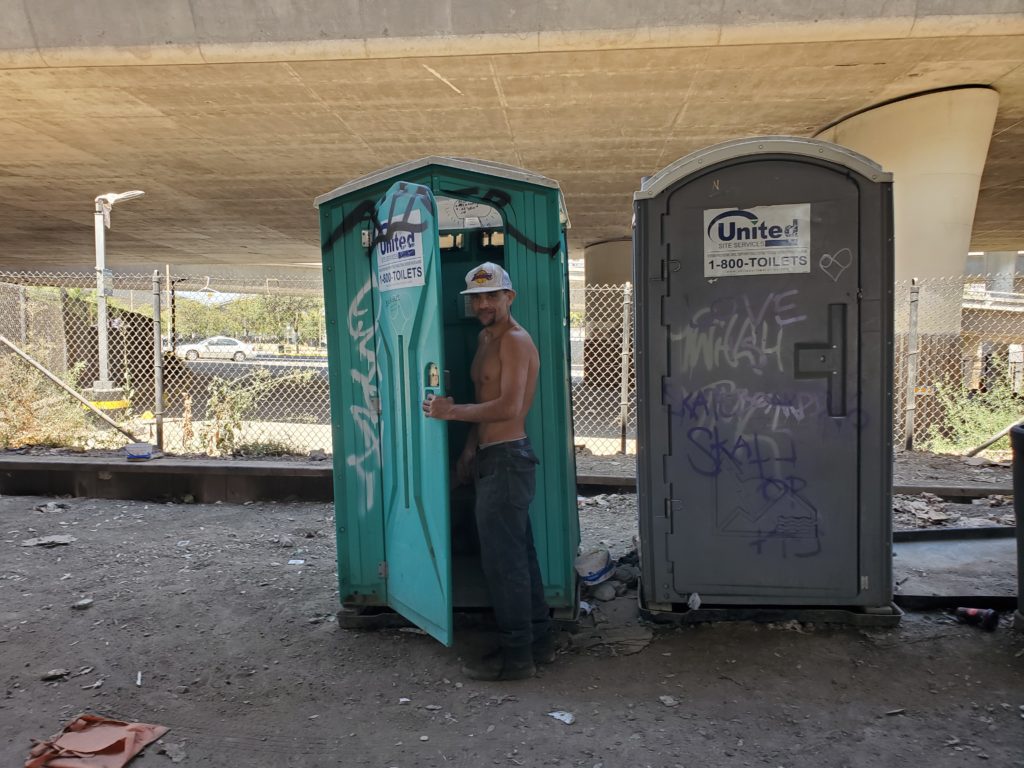Dumpsters that allow homeless people to keep their camps clean make a world of a difference. But getting that and other utilities can be challenging depending on where an encampment is located.
Last week, San José Spotlight reported on a South San Jose homeless encampment that lacks dumpsters, hand washing stations and port-a-potties, leaving unhoused residents without a place to wash up, use the restroom or throw away trash. Homeless advocate Gail Osmer explained that the city denied the camp those utilities because there is no driveway for service trucks.
The absence of bathrooms and dumpsters puts the camp at risk of closure because the city prioritizes clearing encampments that are located next to fragile creeks or waterways, present health or safety concerns, block a street, sidewalk or driveway, have large amounts of trash and debris and receive a significant amount of public complaints.
Some encampments in San Jose are equipped with basic amenities that significantly improve the quality of life of the residents.
In the encampments across from the Children’s Discovery Museum on Woz Way in downtown, portable toilets and dumpsters are easy to spot from the street. Osmer described two of these camps by the freeway as “upper” and “lower” Woz.
In the two camps, the port-a-potties are paired with hand washing stations and are maintained every day.
Tim, who did not share his last name with San José Spotlight, is a disabled veteran who has lived in the upper Woz camp for two of his 30 years on the street. He said he arrived at the camp before there were any utilities. He recalled an ever-present six-foot wall of trash along the outer edge of the camp and human waste everywhere.
The bathrooms not only improve the camp environment, but also daily life for people living in the camps. Before the port-a-potties, some residents walked to use the public bathrooms in local parks, Tim said.
In addition to the dumpsters and toilets, Tim said police have also made a difference with their trash collecting efforts and intervention.
“I’m not a fan of the police, but they did a really good job cleaning up and kicking out bad people,” Tim told San José Spotlight.
Grant, who did not give his last name, said he was the first person to live in the lower Woz encampment. He recalled seeing feces and urine everywhere and having to go to a park to find an actual bathroom.


Encampment hygiene services are coordinated by BeautifySJ and the Housing Department’s Homeless Response Team. According to Daniel Lazo, spokesperson for San Jose’s Parks, Recreation and Neighborhood Services, utilities such as dumpsters, port-a-potties and hand washing stations are provided to the largest encampment sites within the city.
There was once a dumpster down by the lower camp, but the city took it away for unknown reasons. Osmer said she wonders why the city wouldn’t bring the unused dumpster at the entrance of the upper camp down to lower Woz.
Even without a dumpster, the city picks up trash at the entrance of the lower camp every Tuesday. Trash bags are provided to encampment residents.
“The city is very supportive,” Osmer said. “When I ask for dumpsters and port-a-potties or cases of bottled water, they provide it.”
Advocates like Osmer say they wouldn’t have to push for utilities if the city sanctioned encampments. But a combination of high operation costs and complaints from neighbors who don’t want to live near encampments have kept such camps from being built.
Lazo said the city’s services, outreach, assistance and resources (SOAR) program offers encampment residents street-based case management, connections to support services, trash collection, food and water and supplies.
“Through the SOAR program, our teams already know many encampment residents and have been working with them,” Lazo told San José Spotlight.
Each resident Osmer talked to in the upper and lower Woz camps asked if she had any water with her. “I have to go pick some up from the county. I’ll try to come back Thursday,”she replied.
For those particular camps, there does not seem to be a proactive approach to supplying residents with basic supplies.
While San Jose does not criminalize homelessness, it does spend a large sum of money on clearance and closures of encampments, as well as fencing to prevent camps from forming in the first place.
The San Jose Community Encampment Report by the U.S. Department of Housing and Urban Development (HUD) showed that in the 2019 fiscal year, just under $5 million was spent on clearing out encampments. That’s 57% of the overall budget for encampment response.
Clearing camps is hardly a solution, Osmer said, noting that most people return after an encampment has been cleared out. The HUD report found that only about 20% of encampment residents accept shelter referrals before a sweep.
“Some people are just happier outside,” Osmer said. “And that’s all that matters.”
Contact Kristen Pizzo at [email protected].


Leave a Reply
You must be logged in to post a comment.